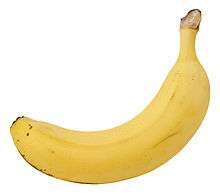Pisang Awak
Pisang Awak is an edible banana cultivar belonging to the AABB banana cultivar group. This cultivar is grown worldwide.
| Musa 'Pisang Awak' | |
|---|---|
 Unripe pisang awak | |
| Hybrid parentage | Musa acuminata × Musa balbisiana |
| Cultivar group | AABB Group |
| Cultivar | 'Pisang Awak' |
| Origin | Widely distributed |
Etymology
'Pisang Awak' is also known in Australia as 'Ducasse' and 'Kayinja' in Uganda.[1][2] The Malaysian name pisang awak is more commonly used among research institutions.[3][4] In Thailand it is known as kluai nam wa (กล้วยน้ำว้า, pronounced [klûaj nám wáː]).[5] The term nam wa has crossed over into the Khmer language where the banana is known in Cambodia as chek nam va (ចេកណាំវ៉ា),[6][7] but is known in the Khmer-speaking Thai province of Surin as chek sâ (ចេកស) or white banana.[8] This banana variety has multiple romanizations including 'Namwah Tall' (with a superfluous 'h'). In Vietnamese it is known as chuối sứ ("envoy banana") or chuối xiêm ("Siamese banana"). In the Philippines it is commonly called lagkitan in the Southern Tagalog region or botolan in the Palawan region. [9]
As a stout mutation, 'Dwarf Pisang Awak' is known in America as 'Dwarf Namwah' as popularized by Agristarts;[10] and in Thai as kluai nam wa khom (กล้วยน้ำว้าค่อม).[11][12]
Taxonomy
'Pisang Awak' is a cross between Musa acuminata and Musa balbisiana. It belongs to the tetraploid AABB genome group, although it was earlier belonged to the triploid ABB genome group.[14] Synonyms include: Musa paradisiaca var. awak.[15]
Uses
'Pisang Awak' (known locally as kayinja) is grown in Uganda for making banana beer.[2]
In Cambodia, 'Pisang Awak' (known locally as chek nam va) is favored over varieties for its multiple uses while other varieties are valued for the fruit.[16] The banana blossoms (at the stage of male flower production) and pseudostem, although astringent, are eaten as a vegetable. The leaves used as a wrap for cooking food such as amok and ansom chek in which the fragrance of the banana leaves is transferred to the food being cooked.[16][17]
See also
References
- Robert Williams. "Australian banana industry: Status and R&D update" (PDF). Advancing banana and plantain R&D in Asia and the Pacific. 13: 19–36. Retrieved June 29, 2011.
- Simon Eden-Green. "How can the advance of banana xanthomonas wilt be halted?" (PDF). Infomusa. 13 (2): 38–41. Retrieved June 29, 2011.
- "Musa Malay Names". Germplasm Resources Information Network. 1999. Archived from the original on May 28, 2010. Retrieved June 29, 2011.
- Koon-Hui Wang; Angela K. Kepler & Cerruti R.R. Hooks. "Brief Description of Banana Cultivars Available from the University of Hawaii Seed Program" (PDF). College of Tropical Agriculture and Human Resources, University of Hawai'i at Manoa. Archived from the original (PDF) on October 26, 2011. Retrieved June 29, 2011. Cite journal requires
|journal=(help) - กล้วยน้ำว้า Archived 2012-03-09 at the Wayback Machine
- ហូបចេកណាំវ៉ា ដើម្បីបានសុខភាពល្អ
- English-Khmer Dictionary by Robert Headley
- Teel, Stephen, Northern Khmer-Thai-English Dictionary, typescript, Surin, July 1988, Vol. I (ก-บ), p. 172.
- http://www.pepper.ph/go-bananas-11-varieties-worth-seeking-philippines/
- "Musa 'Dwarf Namwah'". Agri-Starts, Inc. Archived from the original on June 1, 2011. Retrieved June 29, 2011. This company, provides the bulk of tissue culture bananas in the nursery trade where the varietal names they use is more popular among laymen in America.
- Musa (ABB group) "Kluai Nam Wa Khom" Archived 2010-11-23 at the Wayback Machine
- Randy C. Ploetz; Jody L. Haynes; Aimé Vásquez (1999). "Responses of new banana accessions in South Florida to Panama disease" (PDF). Crop Protection. Elsevier. 18: 445–449. doi:10.1016/s0261-2194(99)00043-5. Retrieved June 29, 2011.
- Musa species (bananas and plantains)
- M. Pillay; E. Ogundiwin; A. Tenkouano & J. Dolezel (2006). "Ploidy and genome composition of Musa germplasm at the International Institute of Tropical Agriculture (IITA)". African Journal of Biotechnology. 5 (13): 1224–1232. ISSN 1684-5315. Retrieved June 29, 2011.
- Influence of Partial Substitution of Wheat Flour with Banana (Musa paradisiaca var. Awak) Flour on the Physico ' Chemical and Sensory Characteristics of Doughnuts - PDFCast.or... Archived 2011-03-13 at the Wayback Machine
- Chiv Linna (February 2002). "What's About The Banana". Leisure Cambodia. Archived from the original on September 27, 2011. Retrieved June 29, 2011. It is often used to make cakes such as Ansorm Chek, Chek Chean, Chek Chhoeng, and Chek Aing
- Deborah S. Hartz-Seeley (July 30, 2009). "Learn to make Cambodian-Style Fish Amok Step-by-Step". South Florida Sun-Sentinel. Retrieved June 29, 2011. The banana leaf adds its own fragrance and flavor to the experience.
